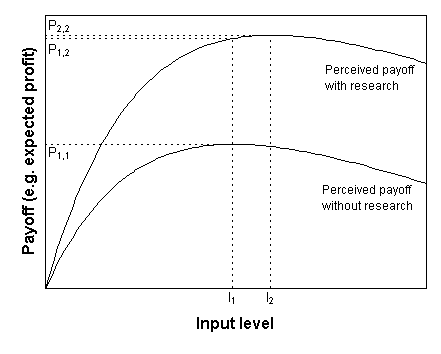43 – New knowledge or new technology: which is better?
Other things being equal, R&D to develop a successful new technology will very often be worth more than R&D that successfully generates improved information for decision making about the same issue. Getting wrong the distinction between these two types of research, or failing to make the distinction, can make a big difference to the estimated value of research.
What is the value of research? It is a complex and multi-facted problem. Thinking specifically about agricultural research, the answer depends on a long list of factors, including:
(a) The predicted or estimated biological, technical and/or management changes from implementing research outcomes.
(b) Any negative or positive side effects (internal or external to the farm) resulting from implementation of the research. This would include any environmental effects and price impacts from changes in supply or demand.
(c) Costs to the farm firm of implementing findings from the research.
(d) Given (a), (b), and (c), the potential economic benefits per hectare or per farm (net of costs to the farm firm but not of research costs).
(e) The scale of potential benefits: the number of hectares or farms potentially affected.
(f) The proportion of the potential scale for which adoption occurs, and the timing of the adoption.
(g) The probabilities of different levels of success from the research.
(h) Direct costs of undertaking the research over time.
(i) The discount rate.
(I am talking about applied research here. Valuing basic research is more difficult again.)
From this long list, in my experience the items with the biggest influences on the value of research are (d), (e), and (f). When looking at attempts to value research benefits (d), a common error is to fail to distinguish correctly between research that generates information (for improved decision making) and research that generates a new technology. Other things being equal (i.e., the other things on the above list), a successful new technology will very often be worth more than successfully applied new information about the same issue. Getting the distinction wrong, or failing to make the distinction, can result in very wrong estimates of research value.
Why is that? First note that payoff functions from management decisions in agriculture often have a relatively flat payoff curve near the maximum. For example, the two payoff curves in the figure below have relatively large ranges over which changing an input level makes very little difference to payoffs. In other words, research that provided information to help fine tune the input level will make little difference to payoffs. As long as you use an input level that gets you reasonably close to the top of the hill, going precisely to the top of the hill doesn’t get you might higher.
To illustrate, suppose that without research, the perceived payoff to different input levels follows the lower curve. Suppose now that new research provides information that the true payoff curve is actually the higher curve. You thought it was one thing – it turns out to be something else. What is the value of this information? Without research, the input level that appears to be optimal is I1 (i.e., that is the input level that appears to give the maximum possible profit) and the anticipated payoff from this input level is P1,1. After the research, the optimal input level is revealed to be I2 and the anticipated payoff from this input level is P2,2. With the new information, the input level corresponding to the top of the hill appears to have shifted. However, the research does not actually shift the payoff function, it only provides improved information about where it is (and where it was all along). If the higher payoff function is actually the true one, then application of the original input level I1 would have resulted in payoff P1,2. The improved payoff resulting from the research is the vertical distance between P1,2 and P2,2 – not a big value.
On the other hand, the outcome of research to develop new technologies is more likely to be an actual rise in the payoff function (e.g. through breeding of higher yielding crop varieties). If the shift in the payoff function illustrated in the figure above was an actual shift resulting from R&D (rather than a perceived shift as previously), the value of the R&D to this decision maker would be the full difference P2,2 – P1,1. The benefits of this type of R&D are not reduced by the presence of any flat payoff function. From this it can be seen that, other things being equal, there are good reasons to expect that successful R&D intended to improve management decisions about existing technologies will pay off less than successful R&D to develop new, higher performing technologies.
For similar reasons, payoffs from agricultural scientific communication (extension or technology transfer) that provides information useful for management decisions about existing farming technologies will also struggle to overcome the influence of flat payoff functions. Unless the information suggests management practices that are substantially different to those in current use, increases in payoffs are unlikely to be large. This suggests that extension providers should target issues where the technologies are new and unfamiliar to farmers, or where for some reason farmers have developed clear and important misperceptions about the technologies.
David Pannell, The University of Western Australia
Further Reading
Pannell, D.J. (2006). Flat-earth economics: The far-reaching consequences of flat payoff functions in economic decision making, Review of Agricultural Economics 28(4), 553-566. Prepublication version here (44K).
Pannell, D.J. (1999). On the estimation of on-farm benefits of agricultural research, Agricultural Systems 61(2): 123-134. full paper (61 K)
